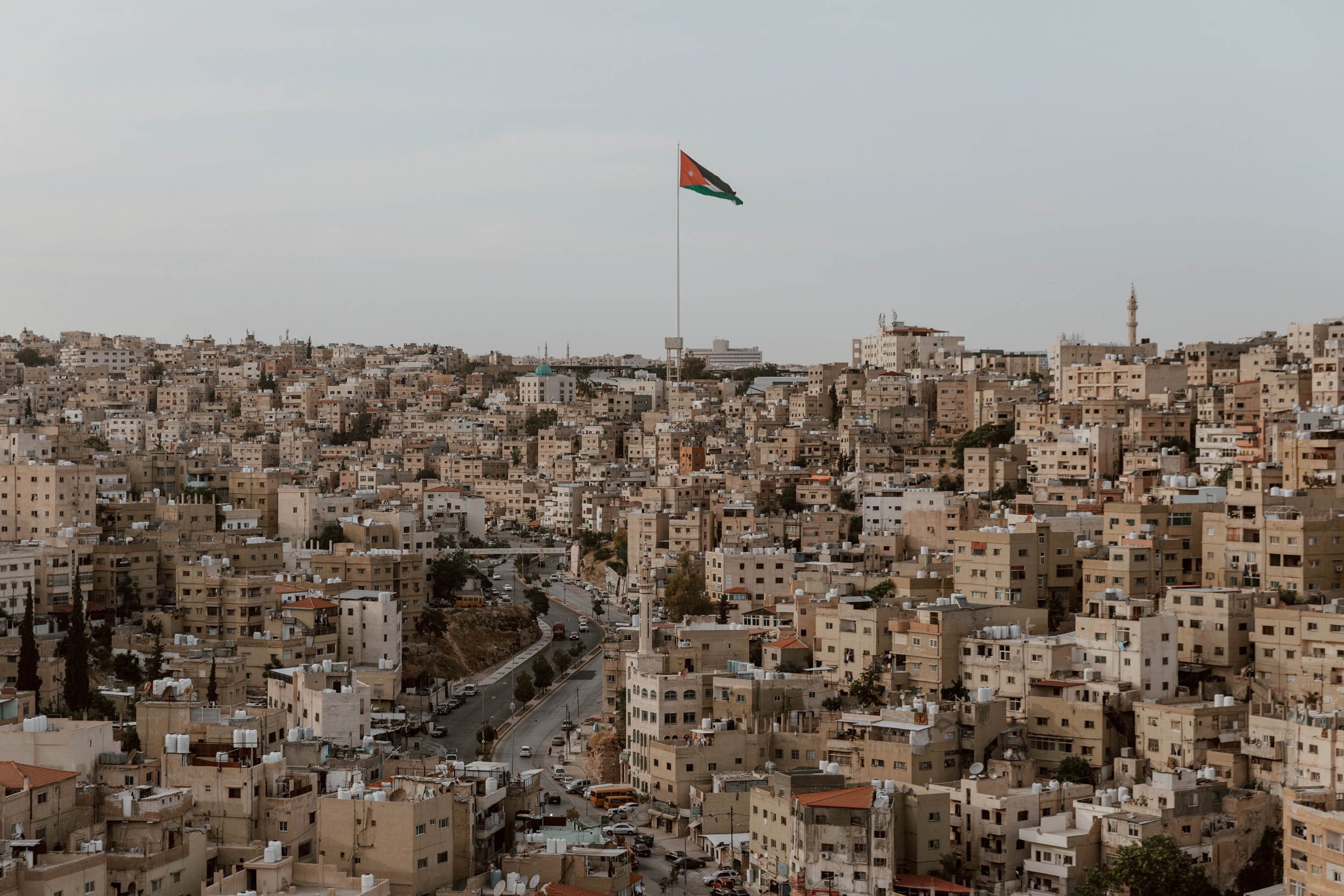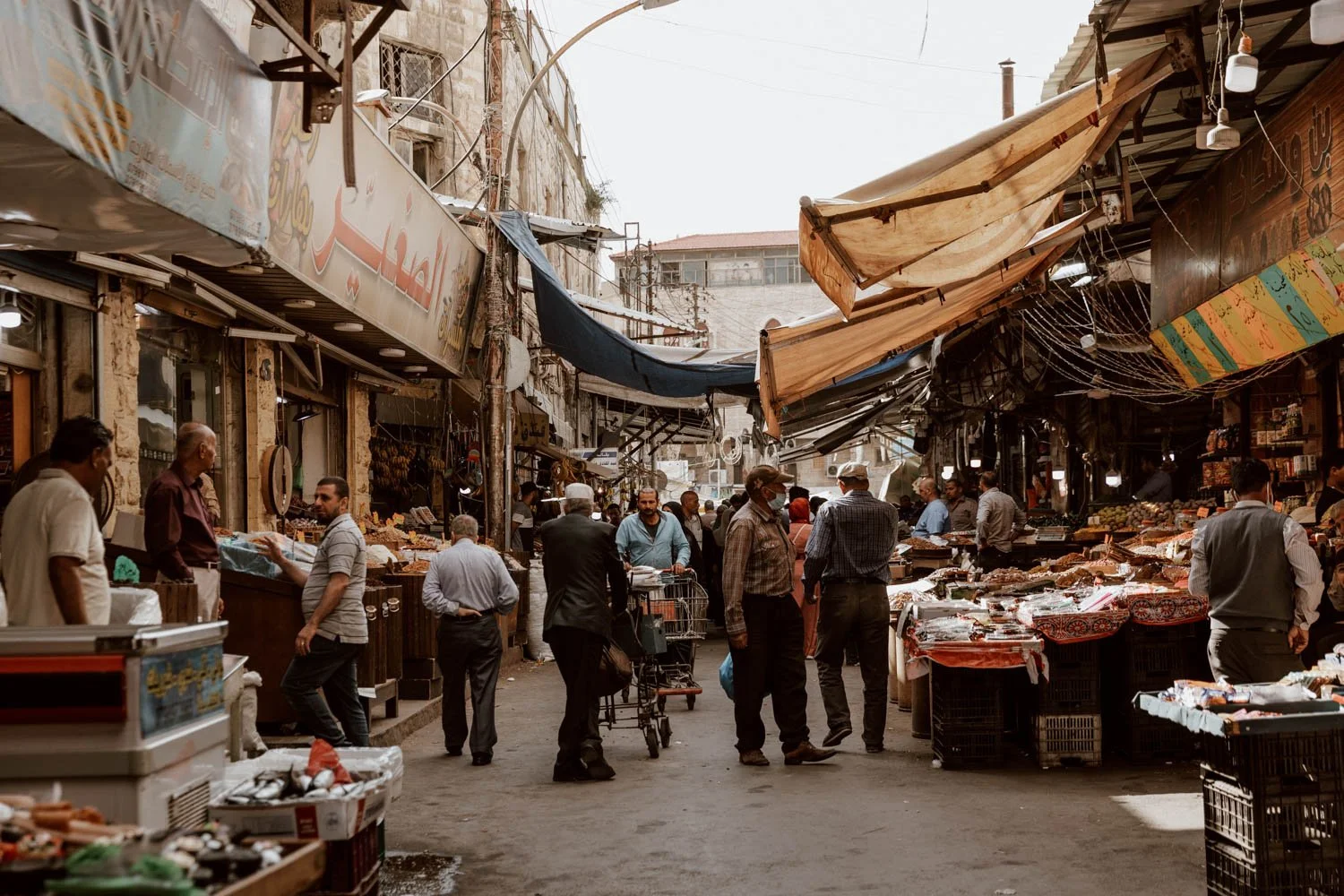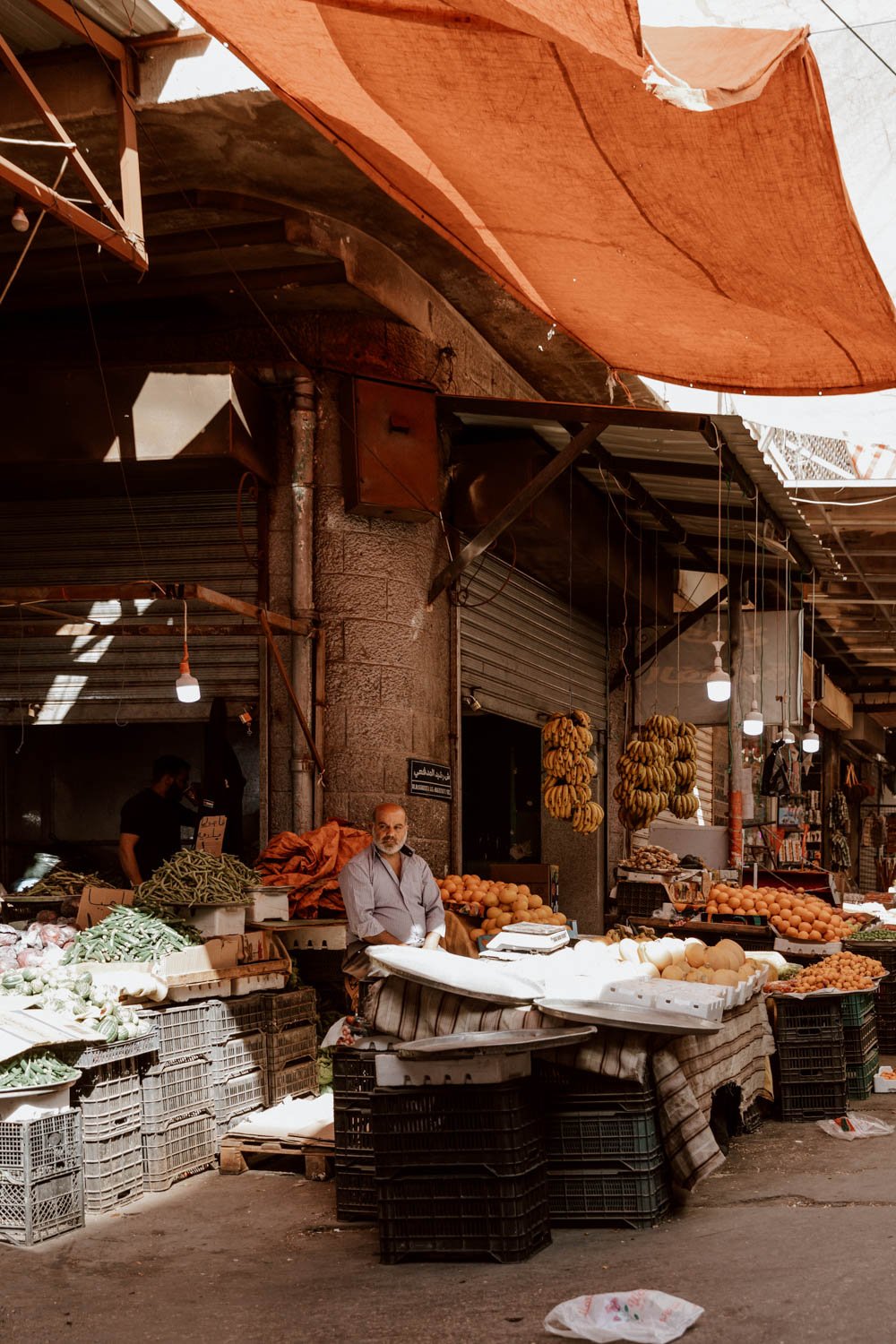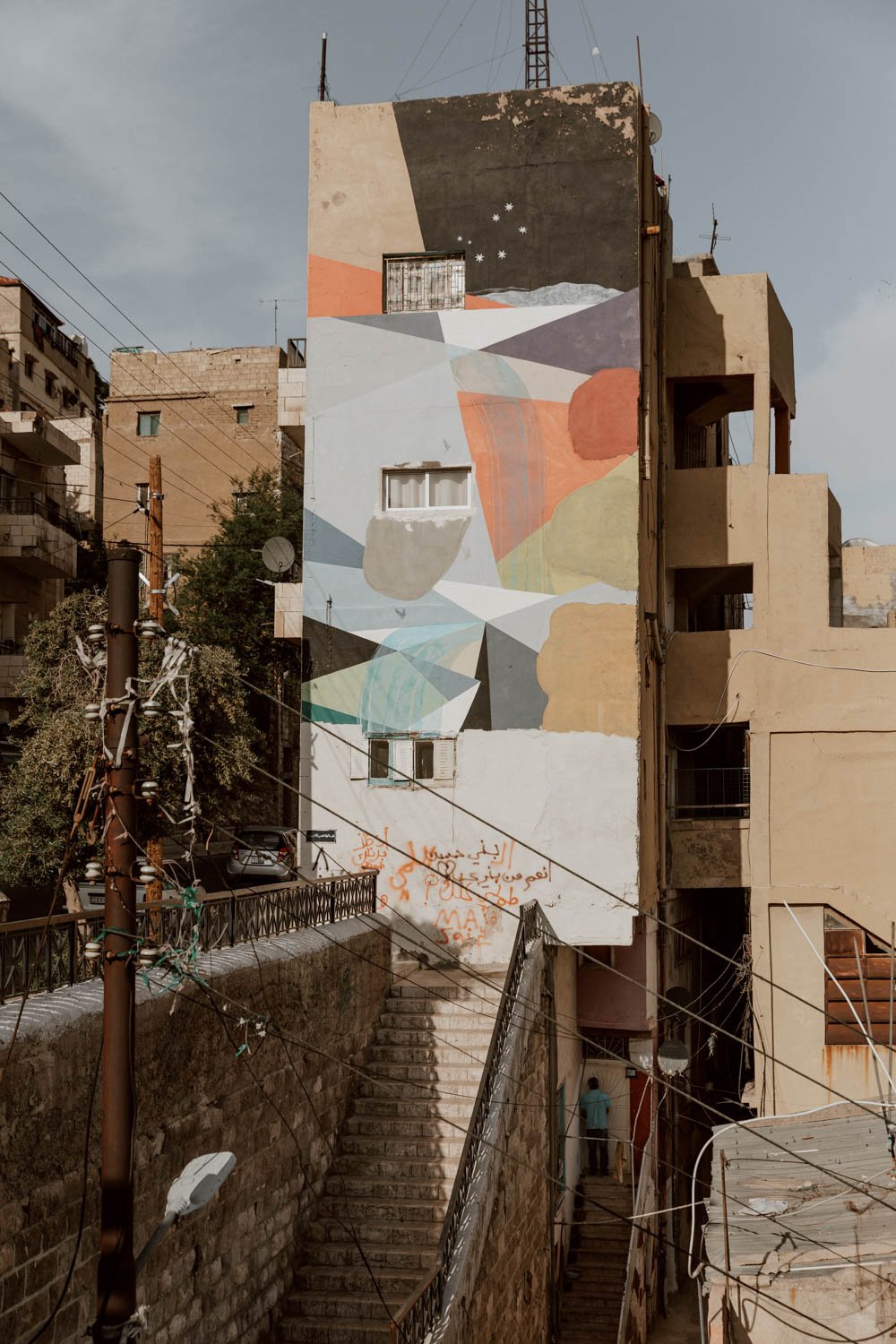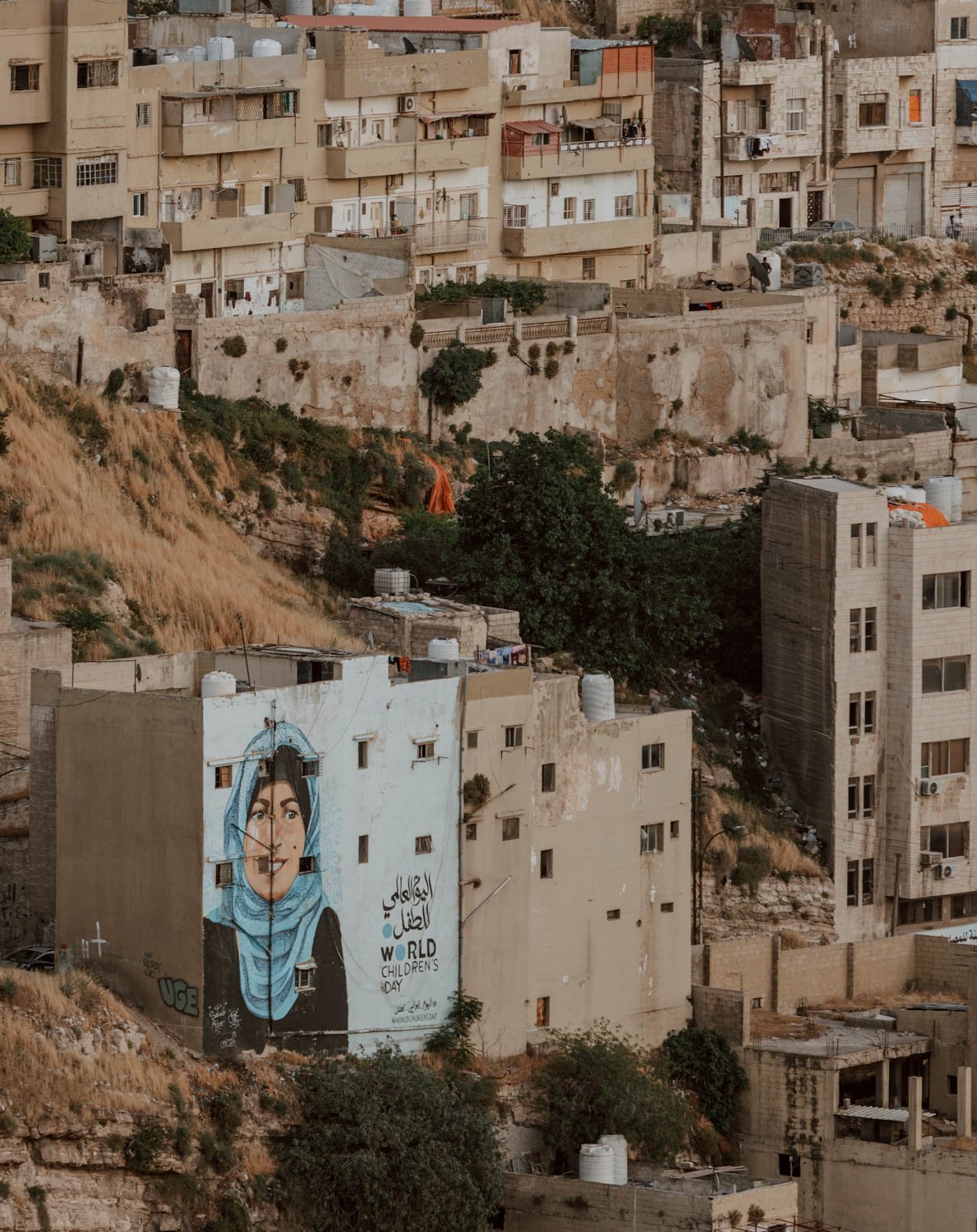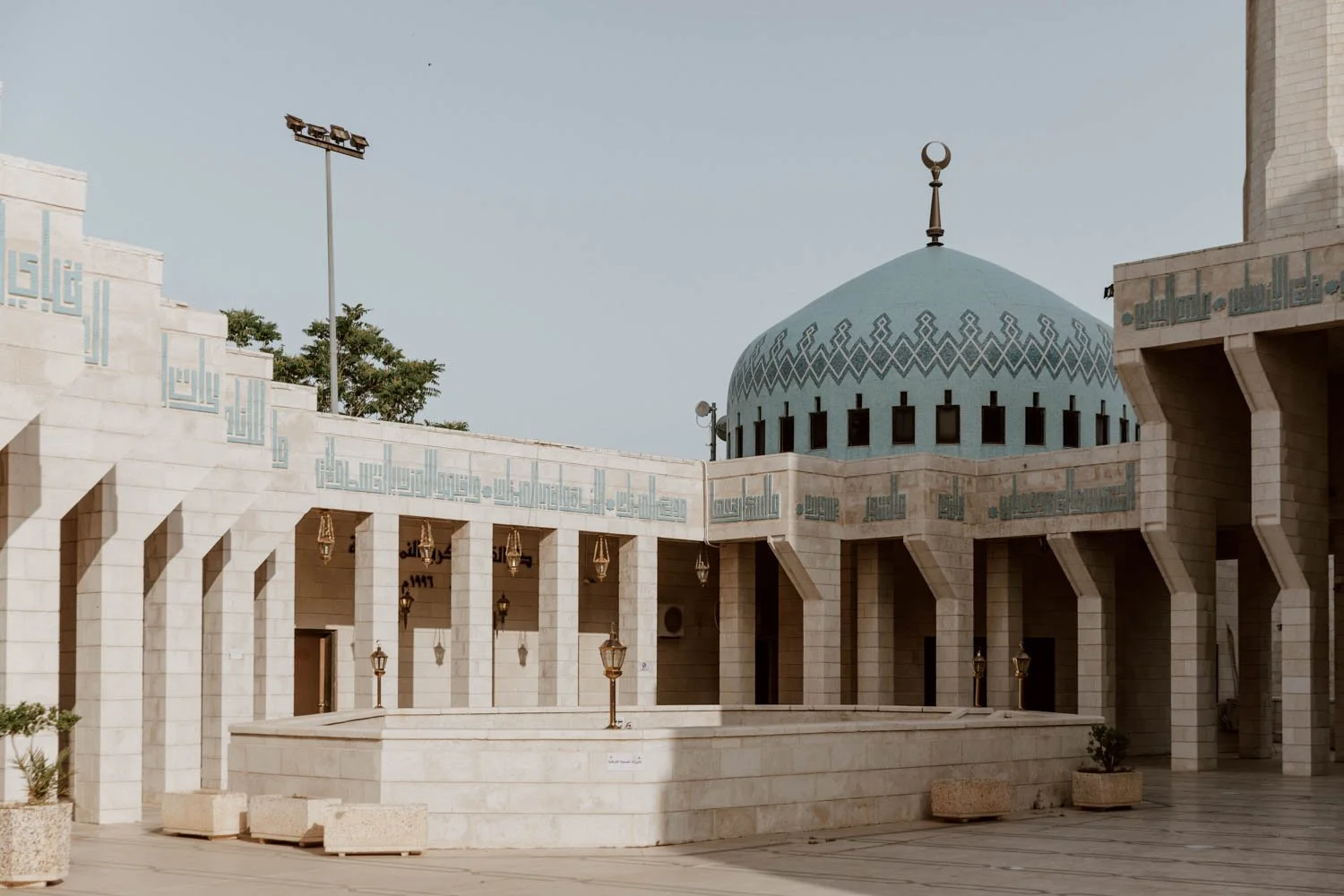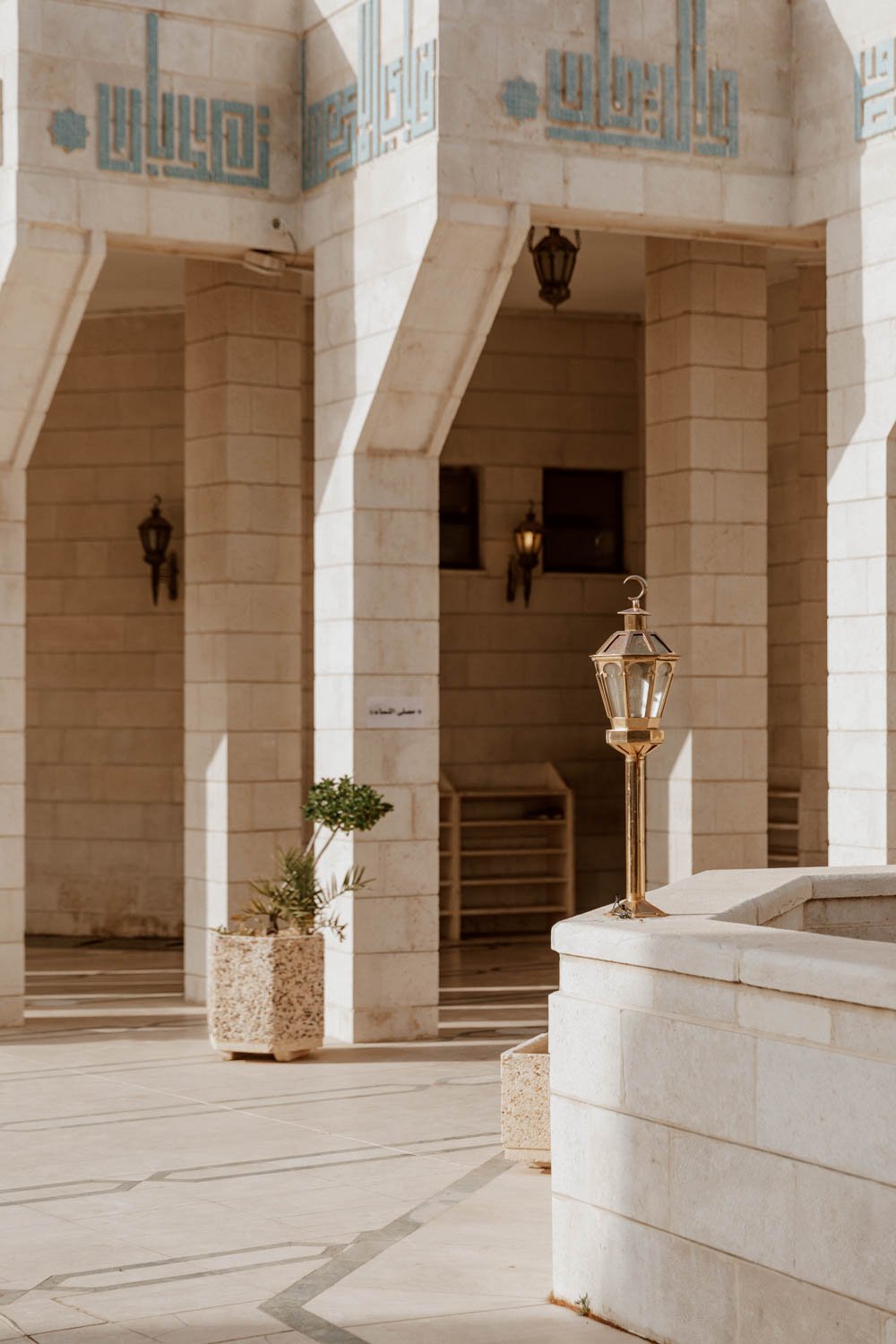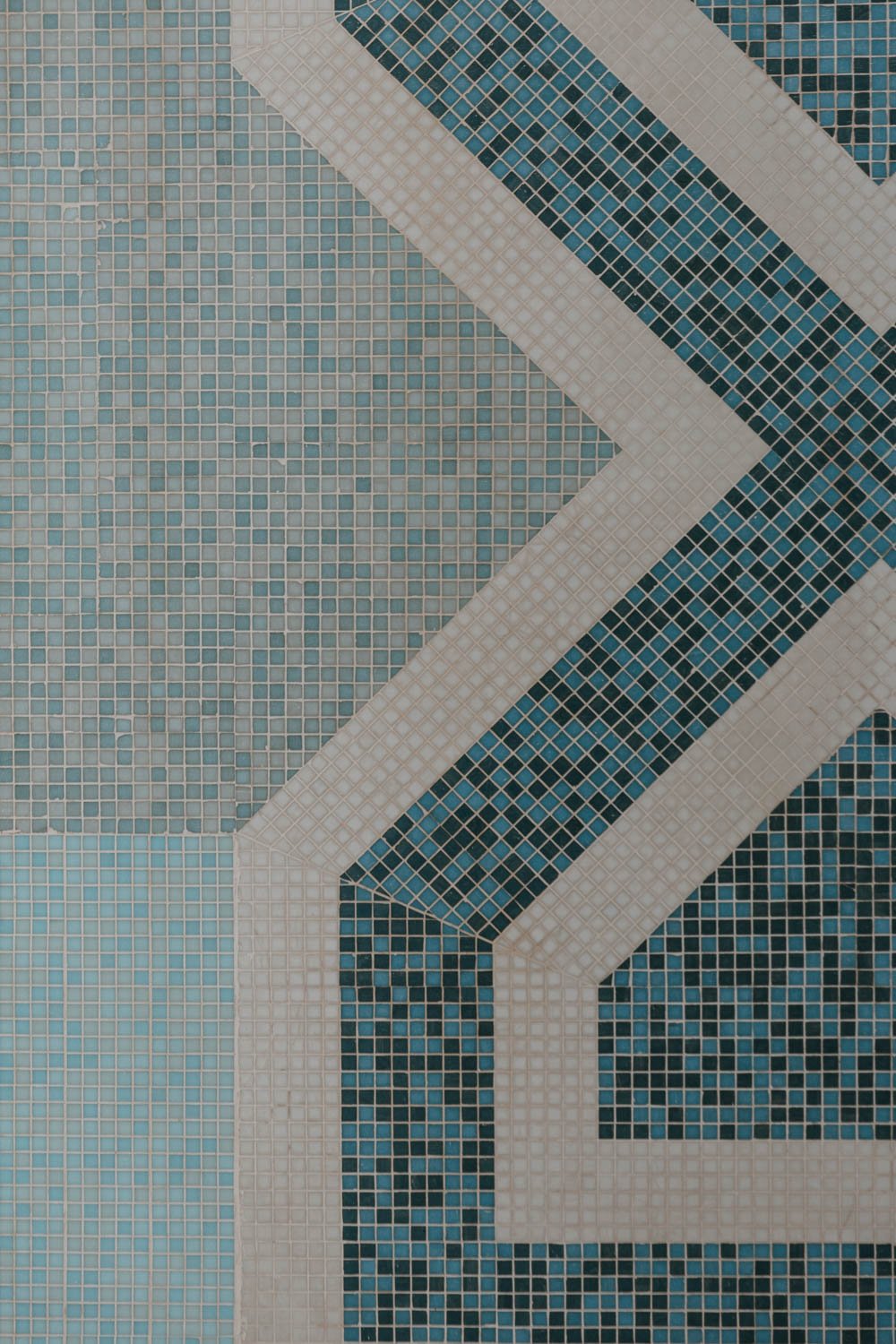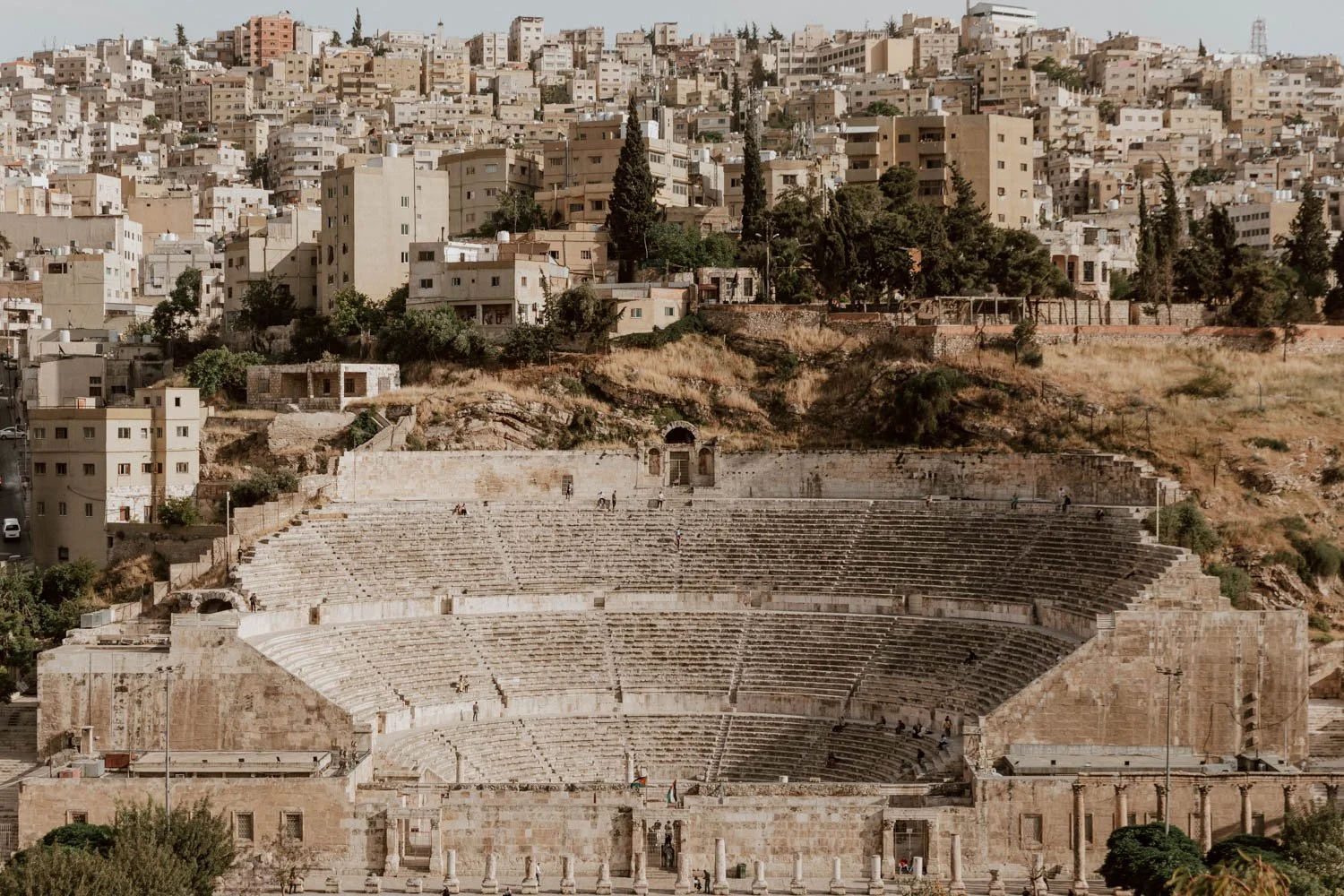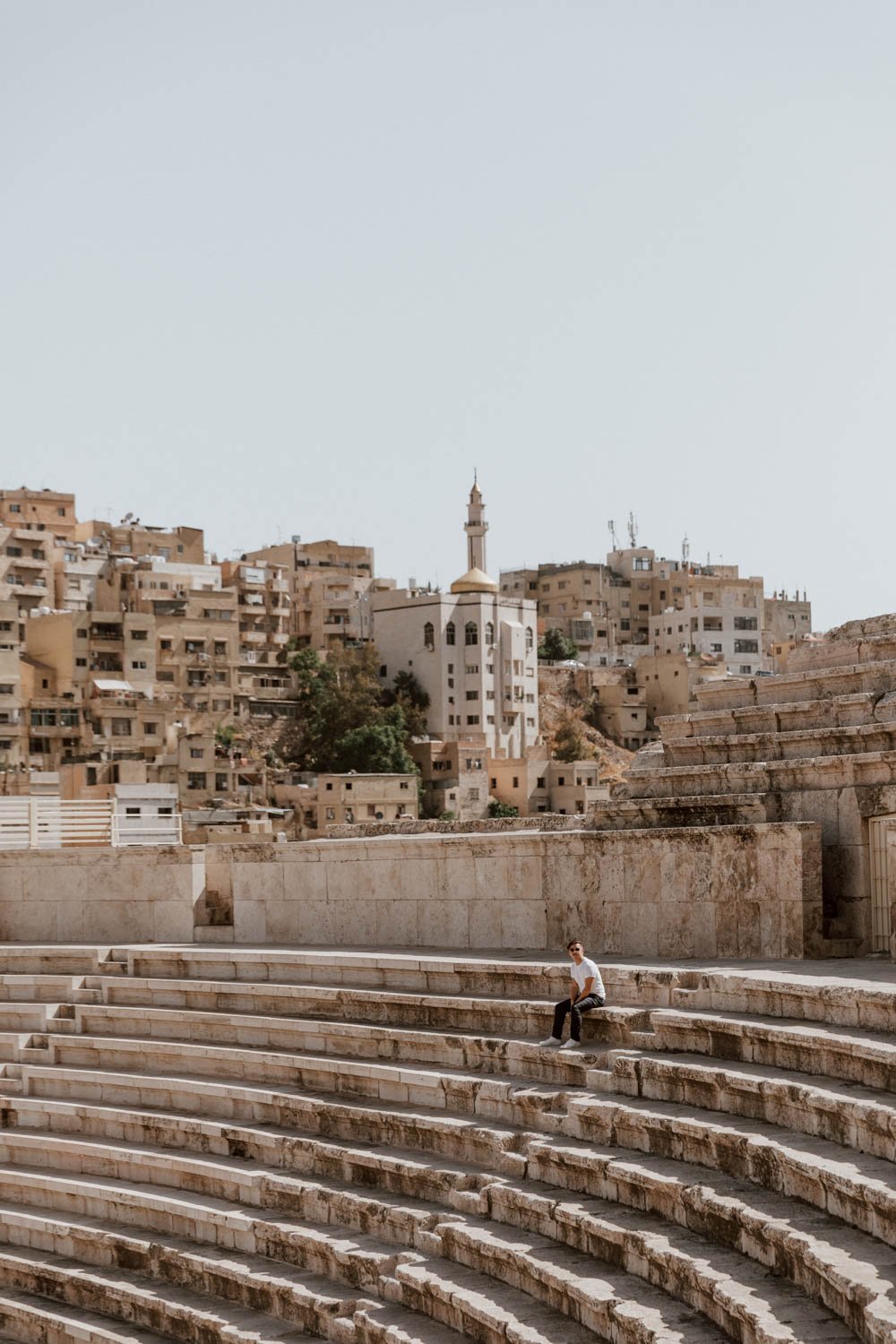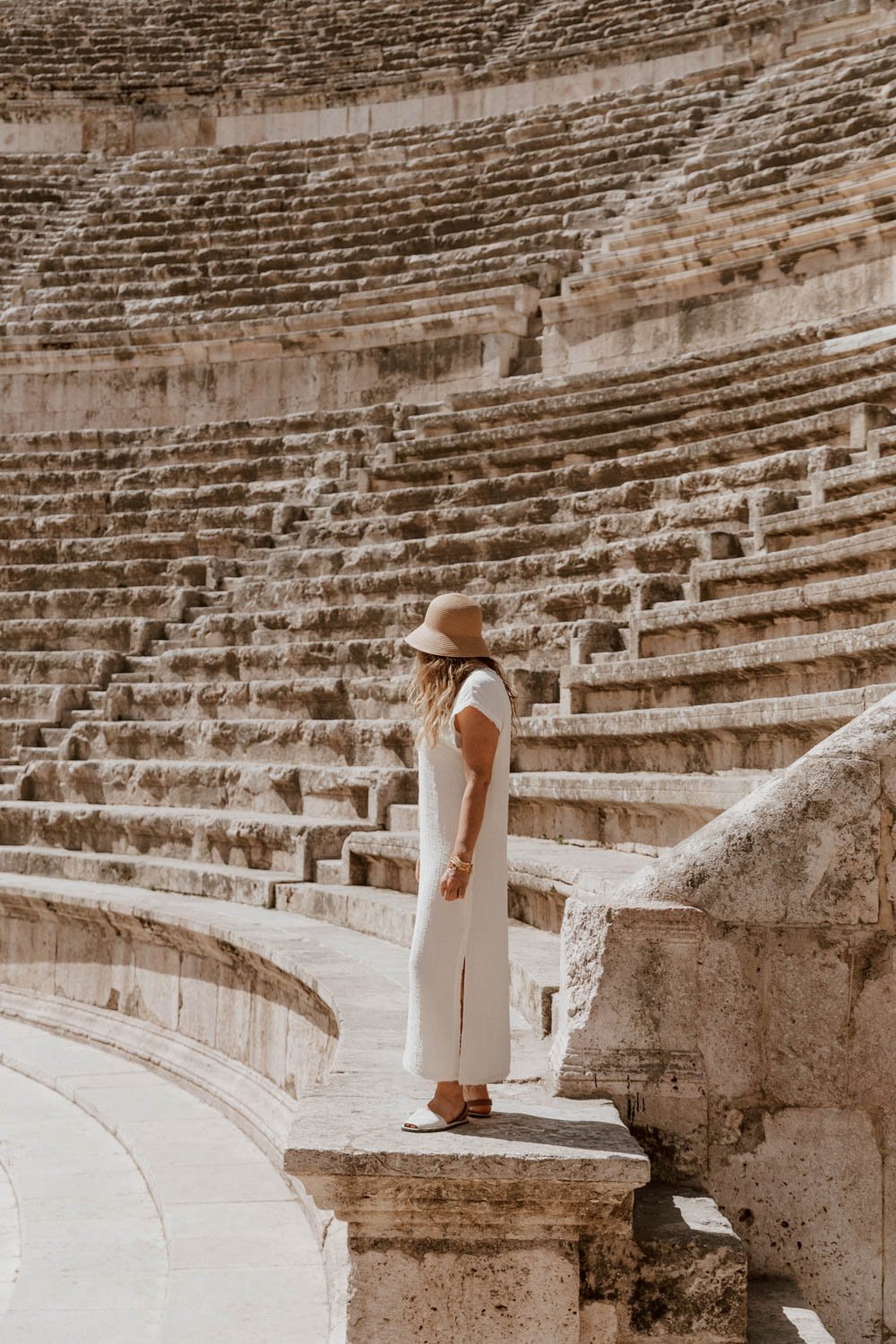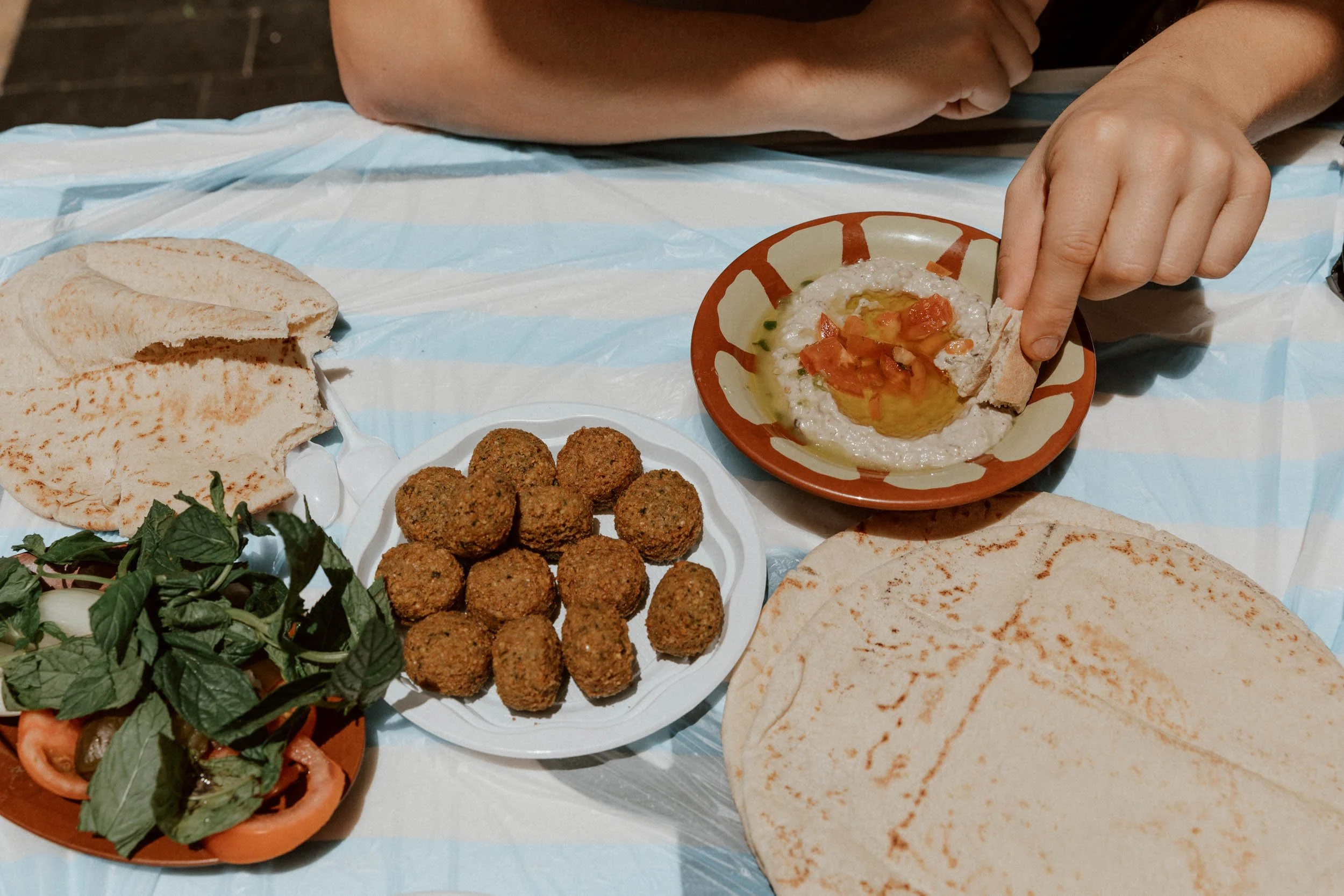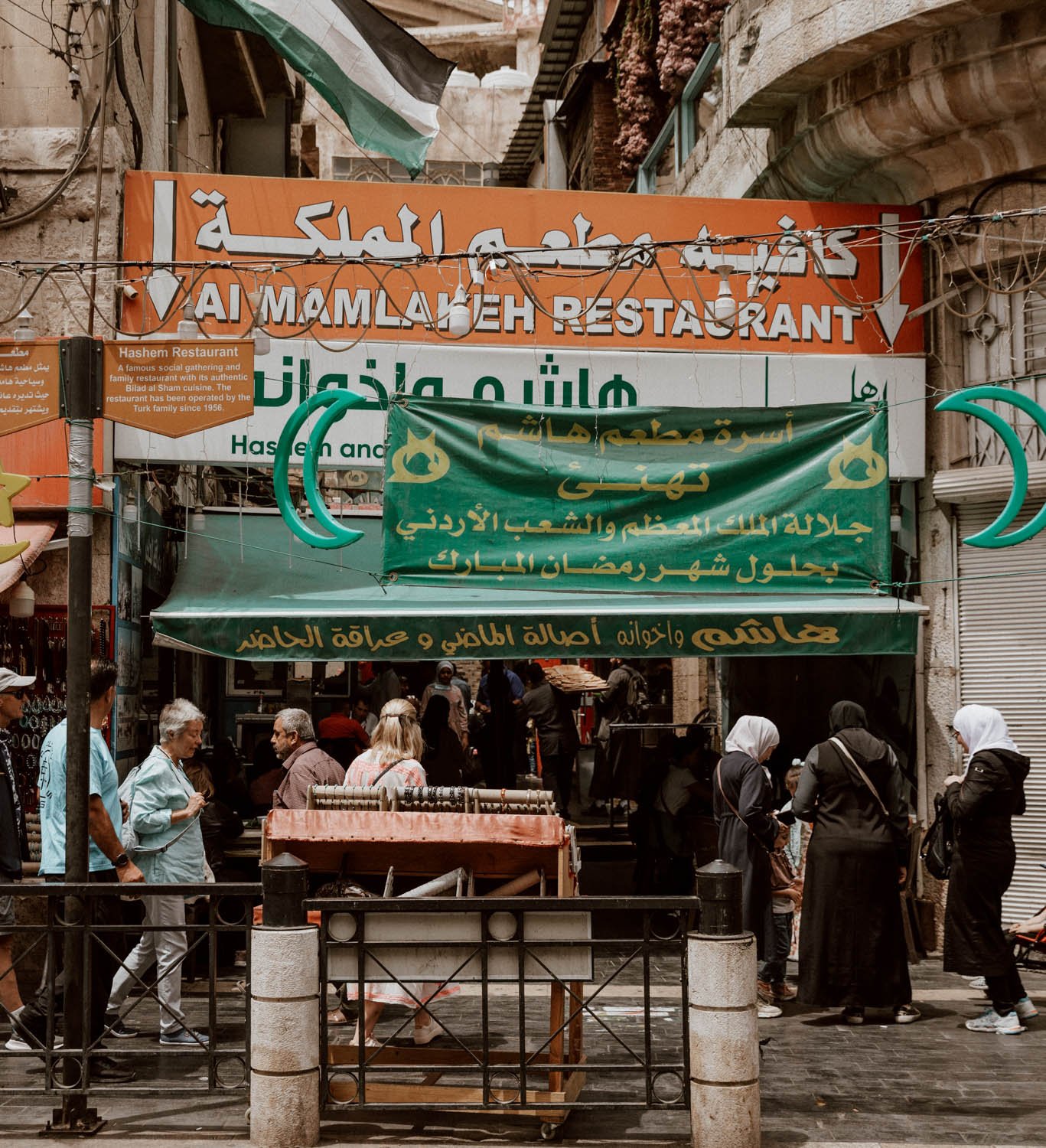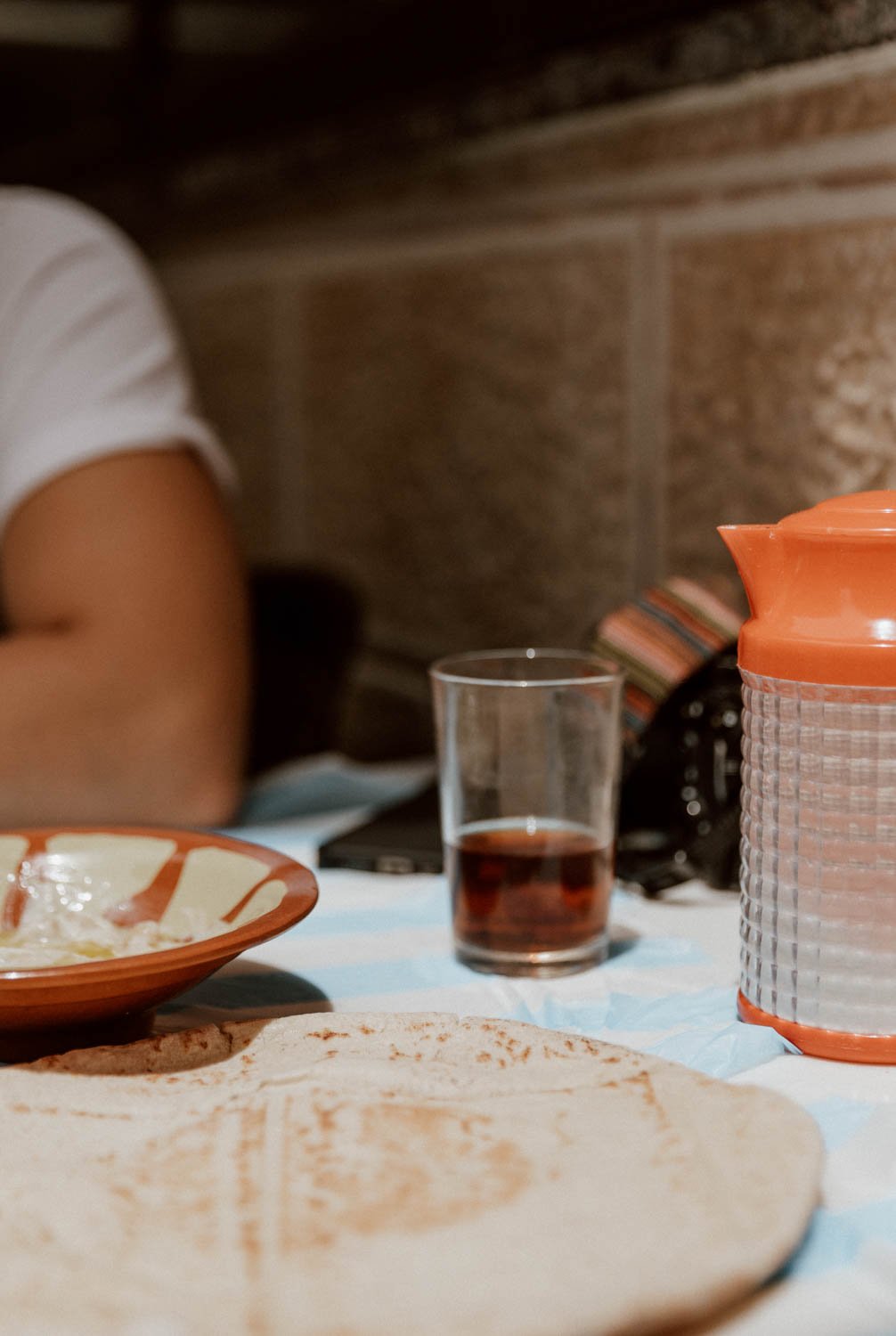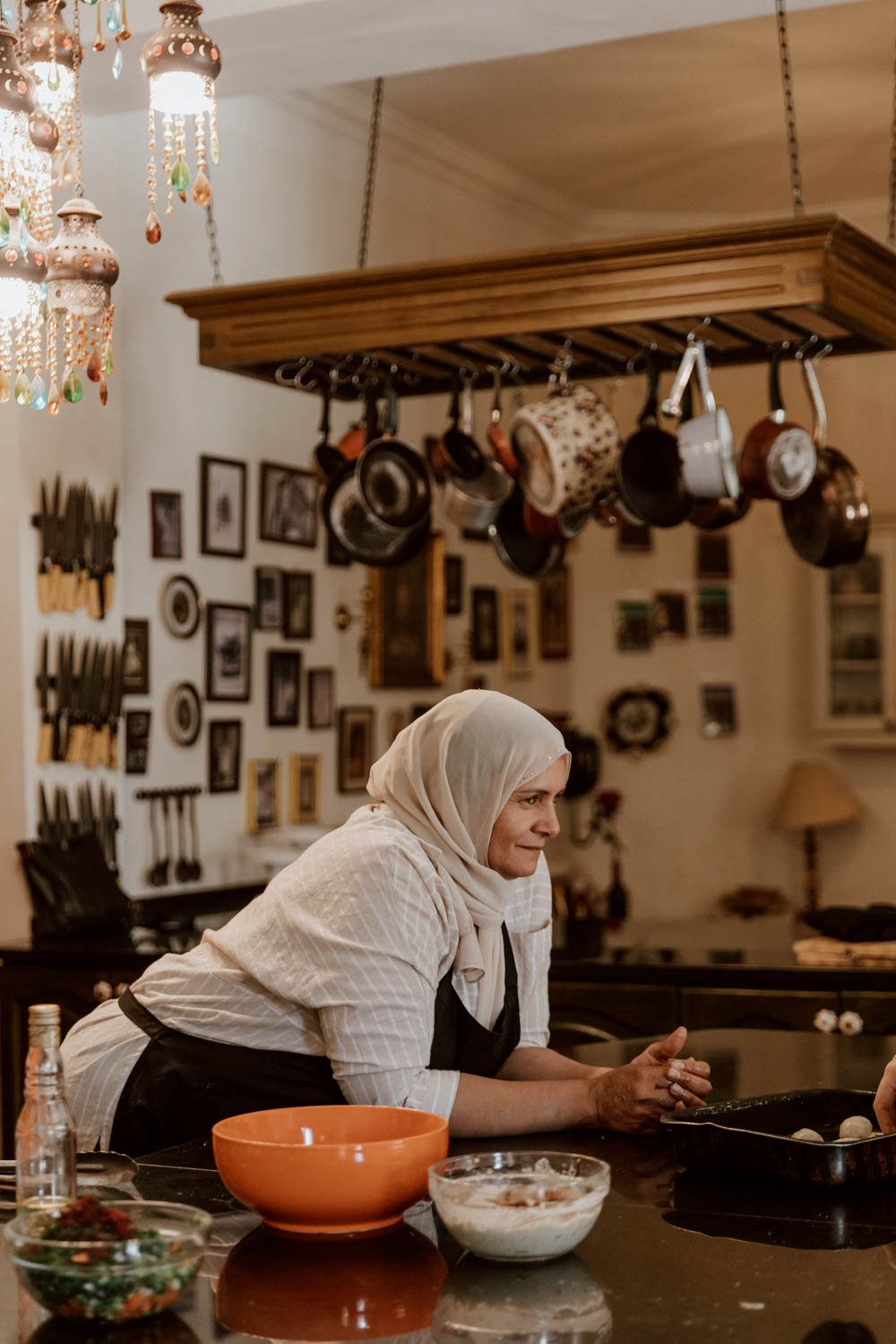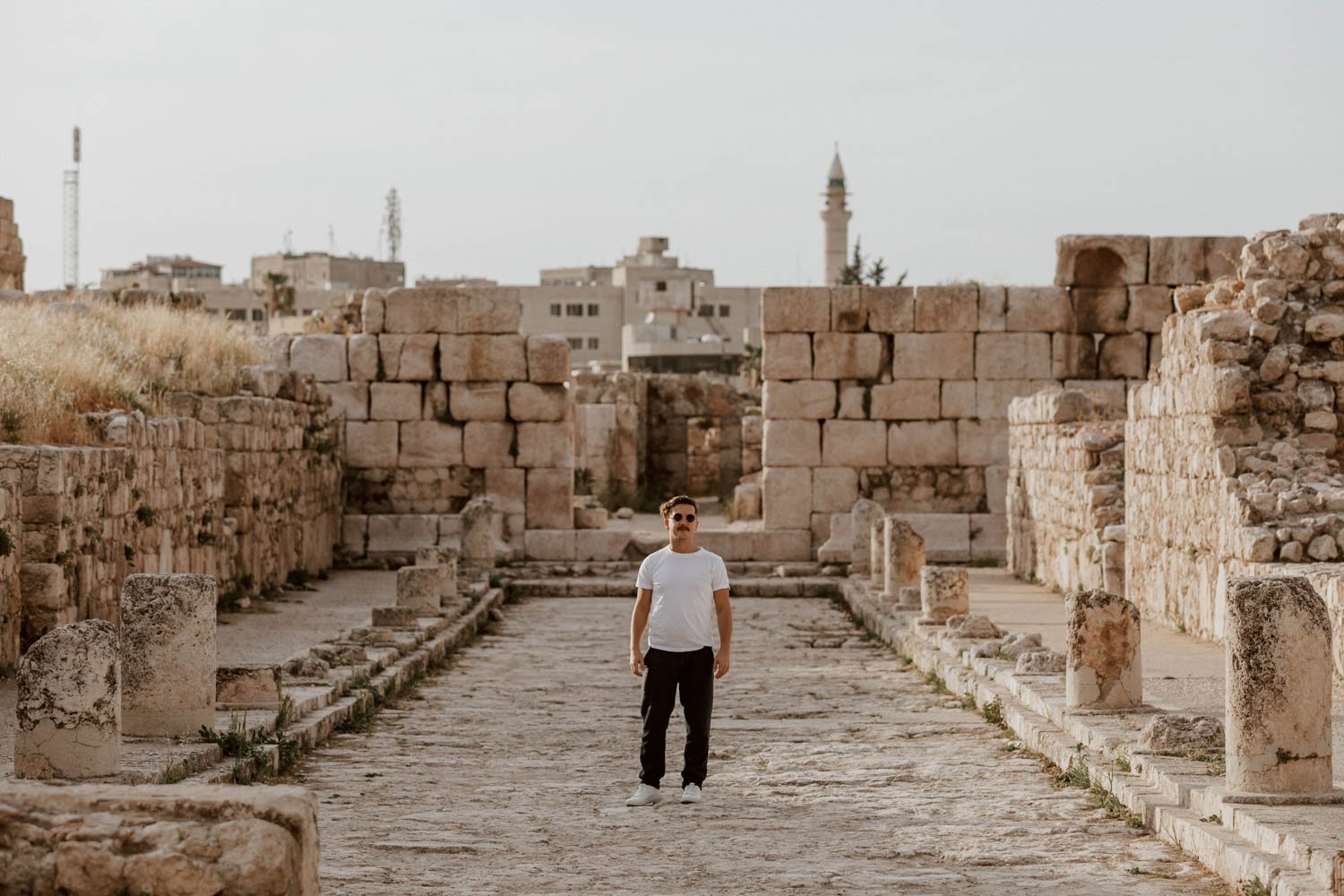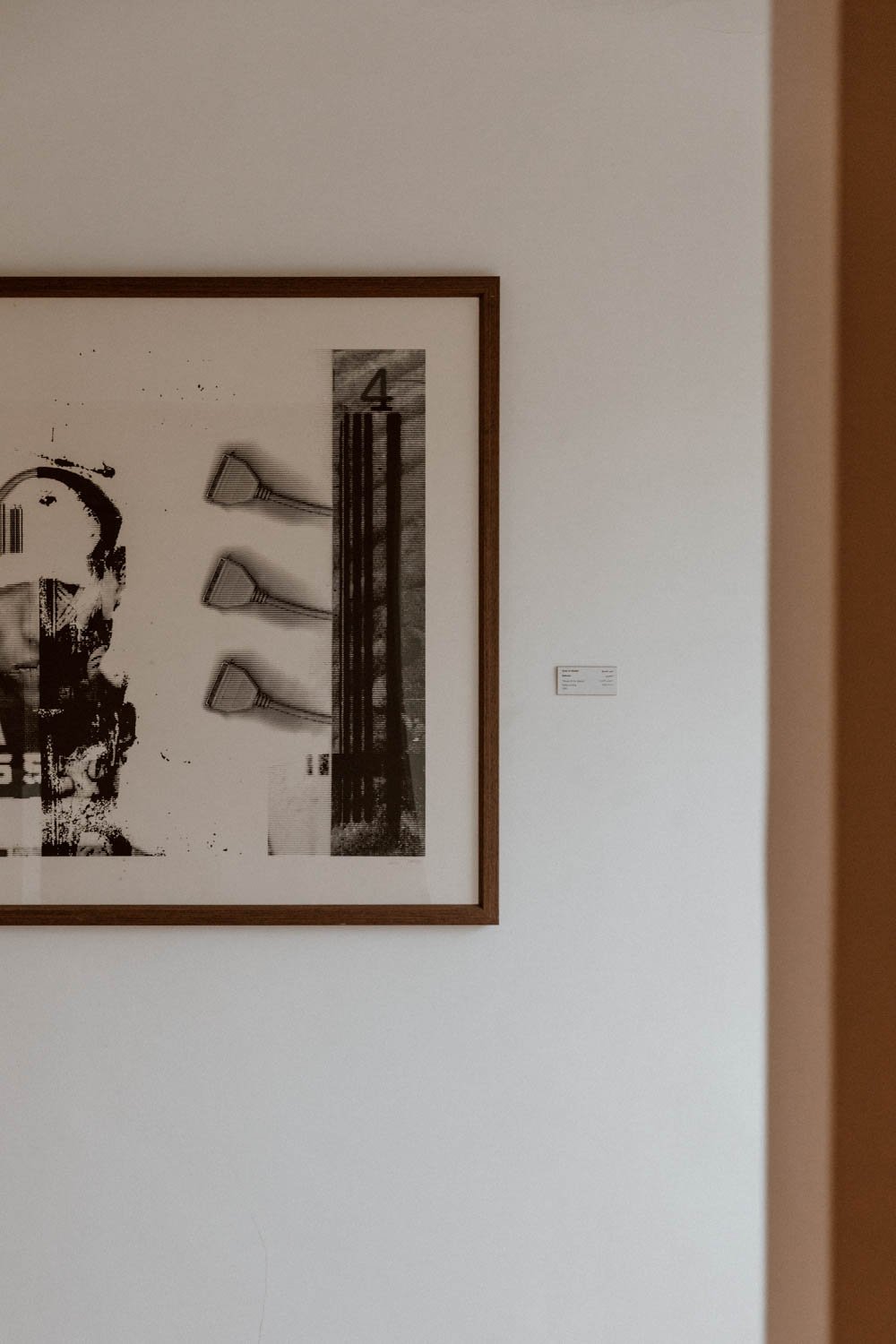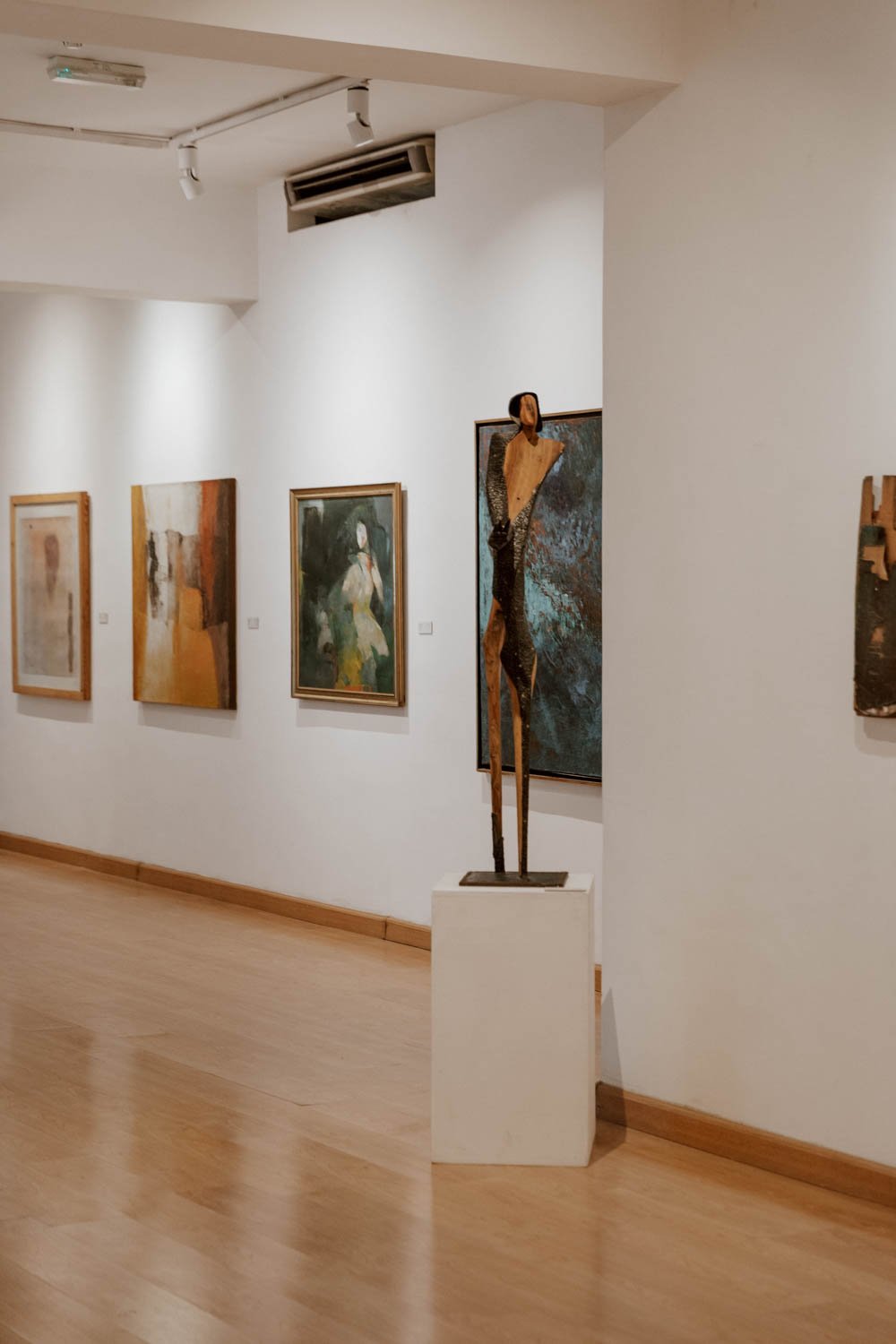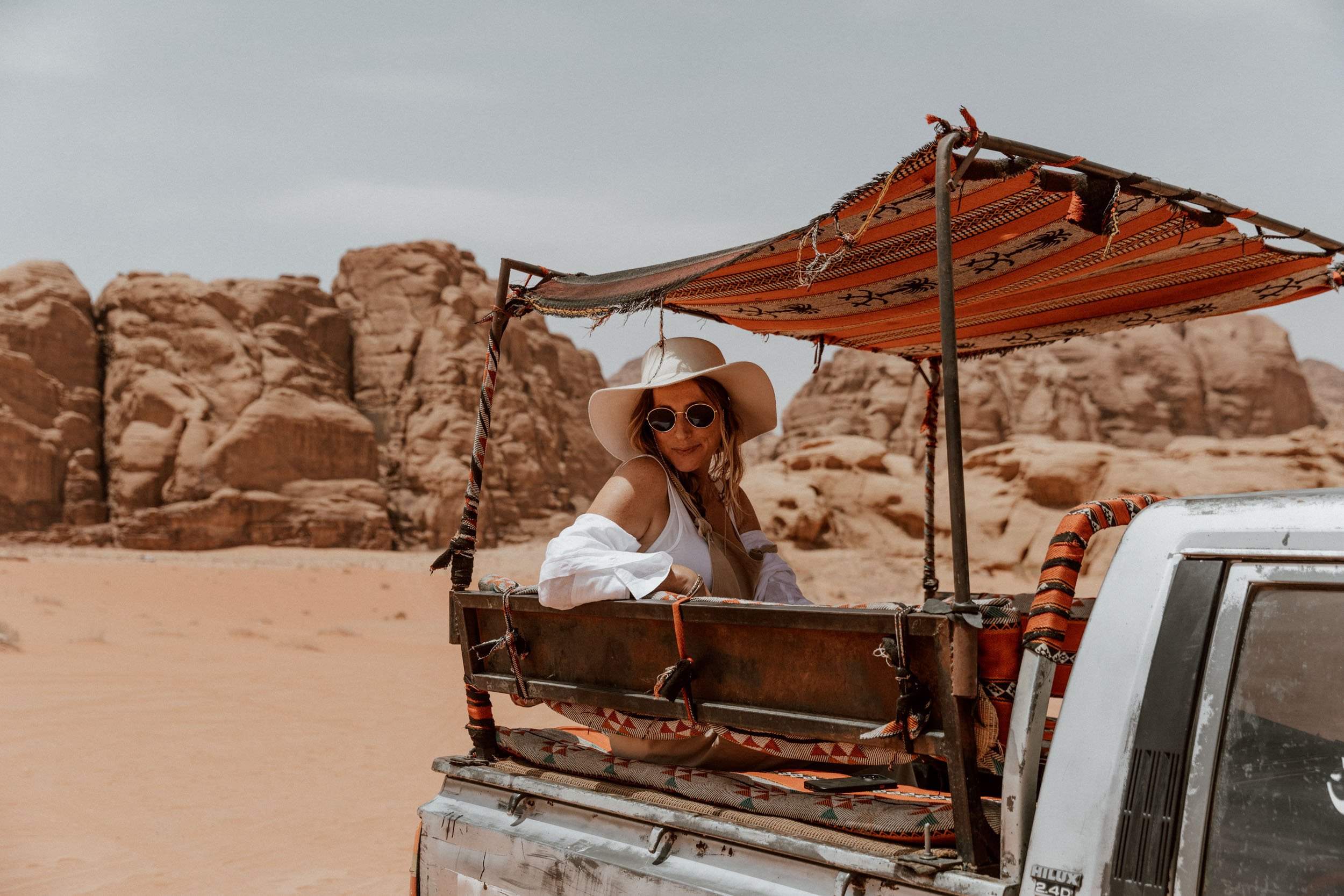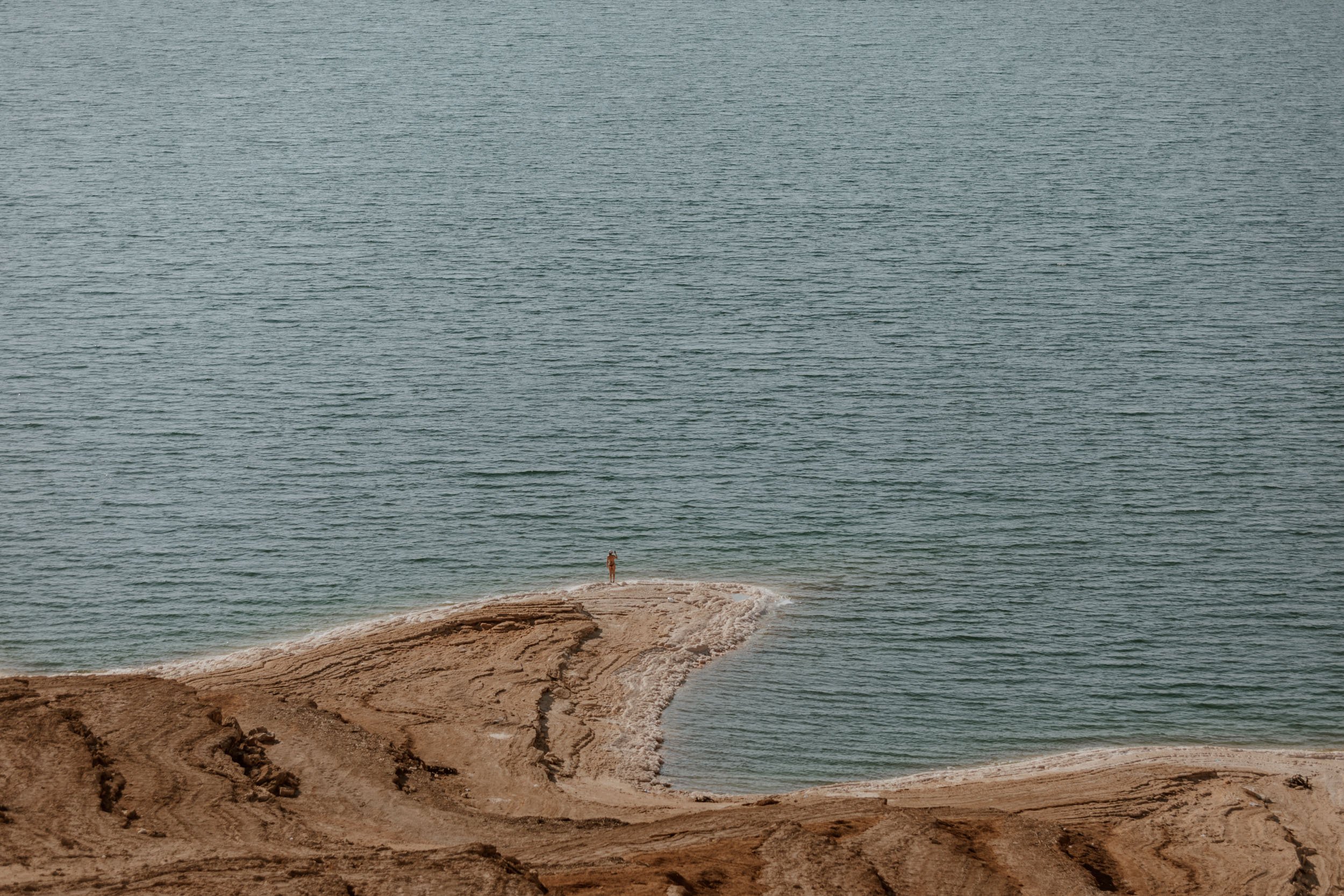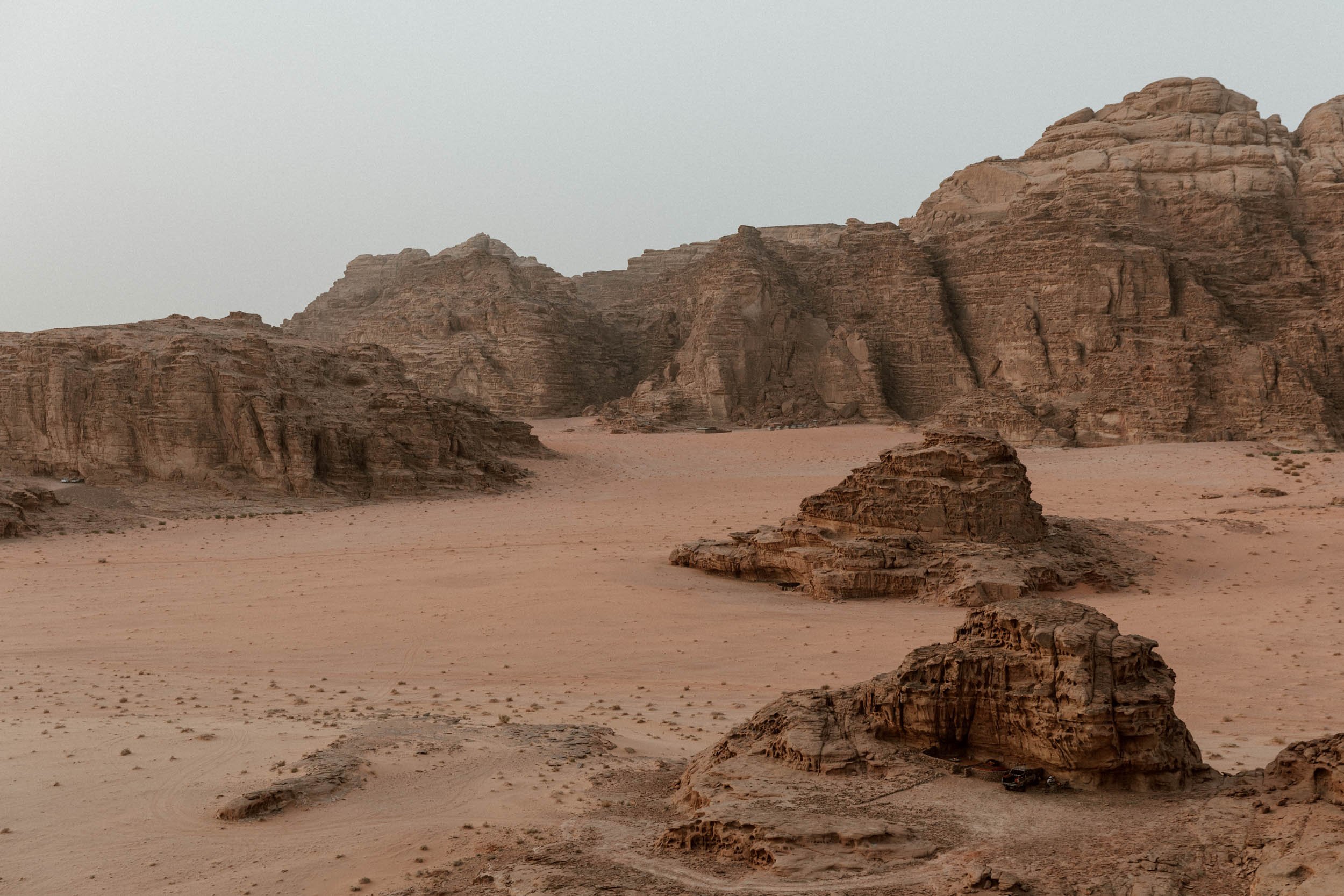Whether you’re basing yourself in Amman to explore Jordan, spending a day or two here before heading south on a road trip or just keen to make the most of a few hours in the capital before flying home, we’ve got you covered! With tips on where to eat, where to find the best views, and historical sites not to miss - here are our very favourite things to do in Amman.
Updated January 2024
A giant in dark blue jeans overlooks Amman.
Ninety-foot high with a forward-looking gaze of determination, he carries a column gripped by both callused hands above his keffiyeh-wrapped head.
His dress and his cargo are a none too subtle nod to the cultural, political and geographical position Jordan has straddled for centuries: between the ancient and the new, the traditional and the modern, the east and the west.
A relatively new nation tasked to stoically carry the burden and privilege of so much history.
Perhaps such takes fall into the trap of being all too simple and all too obvious, or just peddling the same old traveller clichés about somewhere in the Middle East.
But, one thing that’s certainly true is that to get to grips with Amman, you need to get to a similar vantage point as that painted giant of A Man.
Climbing up and clustering down seven hills, in folds and stacks of beige concrete blocks, the capital city of Jordan doesn’t make much sense to the first-timer. A secret staircase cuts walking time in half or leads to a series of switchback roads where even the drivers get befuddled. The seven hills are less talked about than eight circles, which are actually just roundabouts, you have to look up to eat and down to know where you need to go next. What looks like a short walk to the next neighbourhood may see your thighs burn and back sweat on a steep incline, and at moments you’ll just have to decide that a taxi is the only way to get back to square one, even if you wanted to go to circle two.
This is all part of the fun though.
In this guide, we won’t try to iron out the undulating topography of Amman, but we will try to make it a little easier for you to get your ahead around it and make the absolute most of your time in a city which offers unique experiences for travellers looking to get to know Jordan.
Not simply a place to use a base for trips or tours elsewhere in Jordan, a few days for curious minds in the capital will see you explore bustling markets, art galleries, Roman ruins and a famous mosque, as well as sample some of the country’s most well-known falafel. You can get your hands dirty in a fantastic cooking class, hunt down world-class street art, and seek out the best viewpoints in the city too.
This is 11 Wonderful Things To Do in Amman.
The amman essentials
Size / Home to 4 million, nearly half of Jordan’s population
Time / Ideal for a two-night stay
Access / We booked this easy airport transfer into the city
Shop / Don’t miss the lively Souk Al-Sukar. Travelling by yourself? Consider this excellent private tour with a local
Gallery / Notable arts scene, including incredible street art
Holy / Enter the beautiful King Abdullah I Mosque
Feast / Join a cooking class in Jordan - you can book here
History / Step back in time at the Roman Citadel & Theatre (both included in the must-buy Jordan Pass)
Base / Excellent place from which to explore Jordan - see all our top day trips from Amman here
Stay / We stayed in - and can highly recommend - the Khan Khediwe Hotel
Visit Souk Al-Sukar
Watermelon piles and apricot towers. Supersized pomegranates, dates, pistachios, and fresh daily bread. Live poultry and pigeons proffered from cardboard boxes. Tailors and seamers smoking cigarettes by their sewing machines and patched up suits. Tired eyes and caffeine fixes. Spice mountains and spectacles. Polystyrene packs of strawberries. Shafts of light cutting through rainbow coloured and grease-stained tarpaulin, and notes of coffee, tobacco, fish, and sugary snacks through narrow aisles. Young boys pushing trolleys, woofing and whistling at tourists, veiled women buying from the exclusively men literally manning the stalls, and old boys shuffling through in keffiyeh.
We stayed just round the corner from the Souk Al-Sukar, and would dip in and out of the daily market several times for curiosity, photography, and to spend a few coins on fruits, breads, or something that looked popular with locals (this led to a very tasty, sticky ball savoury something we don’t know the name of).
The market crosses several interconnecting streets and buildings, expands and contracts according to the day and the hour, and you should absolutely head here at least once for a wander, twice to see what you missed, and three times if you’re a photographer.
Where + When | The souk area we’re talking about starts opposite the ruins of the Roman Nymphaeum and continuing to Betra Street - find it here on Google Maps
Some stalls are open from early in the morning, but its starts getting busiest and most interesting from around 10 or 11am. It remains open until the evening, when the fluorescent lights give it a very different atmosphere.
A short walk from here is Al Malek Faisal street, which is sort of the main vein of ‘downtown’ for visitors, where you will find shops selling all manner of perfumes, gold, souvenirs, and ornate, brightly coloured glad rags. It’s also home to several other popular things to do in Amman.
By the way, we highly recommend where we stayed - the Khan Khediwe hotel - if you’re looking for something a little more comfortable in a great location downtown.
There are several other souks in Amman - some weekly, some daily - and we’ve referred to a few of them throughout this post.
Travel Tip // If you’re travelling in Jordan by yourself (or travelling with others but enjoy an extra insight into the places your visit), consider joining a guided tour of the city - this highly-rated two to three hour tour covered by foot and car takes in some of the city’s biggest attractions alongside some you won’t find in the guidebooks.
Street Art Surprises
We’ll put our hands up and admit we were totally ignorant of the street art scene in Amman before we visited.
You shouldn’t make the same mistake: its ubiquity and quality is one of the main reasons we think travellers have to spend time in Amman.
The works here go beyond tags or spray can doodles though, with several-storeys high murals covering the side of beige buildings across the city as well as clever little pieces in unexpected places.
The Baladk Street Art Festival, started by a local theatre in 2013, underpins the scale and scope of street art in Amman. Each April / May, it brings together artists, organisations and the community to celebrate the form and promote the socio-cultural benefits of art, as well as enable the commission of bold new murals.
Beyond an appreciation of the works themselves, and the colour they add to Amman’s relatively uniform palette, the contemporary urban art you can see here is an important shorthand to show that a visit to Jordan isn’t all about desert landscapes, pink rock cities, and the past.
There are other stories to be heard here, and paint and a blank wall is expression for anything from an armada of little paper boats to bold convention-challenging portraits.
Good To Know | There are two great interactive maps pinpointing street art in Amman: Jordan Street Art and The Amman Street Art Documentation Project.
You will see some as you naturally walk around the city, but it’s important to know that many of the best, newest, or most interesting pieces aren’t in neighbourhoods you’ll naturally visit over a stay of two or three days. In fact, not having enough time to head over to some of these is one of our biggest regrets from our two weeks in Jordan.
Therefore, a good option is to join one of the dedicated local-led street art walking tours by Underground Amman, which also doubles up to give different perspectives on the city and life in Jordan.
Their downtown graffiti tour runs on Thursdays, Fridays, and Sundays, whilst their Hashmi street art tour in east Amman runs Tuesdays and Saturdays. Unfortunately we only discovered them shortly after our arrival, and dates didn’t match up to join a tour - next time!
Another option is this highly-rated Alternative Downtown Tour of Amman.
Good To Know // The work we mentioned in the intro by the way is called ‘The Column’ by Jofre Oliveras and Dalal Mitwally. It captivated us on first sight, and this article is a good read on the creation, controversy, censorship, and artistic compromises behind it.
Go Inside King Abdullah I Mosque
The stance varies from country to country, but it's generally rare for a non-Muslim traveller to be able to step inside a mosque.
Although entry is not expressly forbidden by most schools of Islam, mosques in the Middle East are not considered as tourist attractions in the same way as churches and cathedrals are in Europe. There are several core reasons for this, but it's primarily due to stark differences in levels of religiosity in the societies, with mosques continuing to serve as a place of daily religious worship for multitudes in contrast to the sparsely attended and far less frequent, Christian services.
The beautiful King Abdullah I Mosque does things quite differently: tourists are not only welcomed within its white walls and under its magnificent sky blue dome, but ticketed and timetabled.
It’s the only mosque in Amman open to non-Muslims.
Completed in 1989, it was built by the late King Hussein to commemorate his grandfather King Abdullah I, the first of the family dynasty which still rules the country. A verse from the Koran - ''Allah is the light of the heavens and earth” - was a key concept behind the design, and the mosque is a an aesthetically pleasing exhibit of contemporary Islamic architecture. Clean lines and sharp angles, quasi-Brutalist minarets, and the Fabergé egg dome combine to make a visit here more than just about cross-cultural or inter-faith understanding.
Where | The mosque is in the Al-Abdali neighborhood of west Amman (find it here on Google Maps), next to two old churches. We walked to it after our cooking class, but would recommend jumping in a taxi from downtown (1-2 JD).
The entrance for non-Muslims is best found by standing outside the Coptic church with the big Red Cross (Google Maps) and crossing over from there, and you’ll be greeted by someone in a souvenir shop.
When | According to the sign we saw, non-Muslim visitors can enter from 8am to 6pm, seven days a week. However, you cannot enter from 90 minutes before Friday prayers (the busiest day), or for the half hour afterward. Non-Muslims are also not permitted half an hour before/after each prayer time throughout the week.
Prayer times change all the time, and occur five times a day, so our advice is simply do some internet research before you head off or simply arrive and ask; you can wait around or walk to the nearby Jordan National Gallery of Fine Arts Park before coming back after prayers.
Tickets | Entry is 2JD per person, cash only. You have to enter the souvenir shop first, then exit it to find the man to pay. You’ll then be directed to enter a small display centre with photos and city models, but you then need to exit this and go up the staircase to find the entrance to the main interior section of the mosque. You can also walk around the large courtyard.
Good To Know // In a current or historic place of worship, it’s important to act in a mindful, respectful way.
· Women must cover their heads, arms and legs to enter the mosque, and this is best done with the abayas provided for free in the gift shop. Even if you are dressed modestly, you will likely be provided one of these smocks as the hood allows hair to be covered and the shapeless shape is preferred in this environment.
· Men have far fewer obligations to cover up…but we recommend avoiding wearing a vest or shorts (trousers are best). Don’t wear hats.
· Be curiously respectful, stay quiet, and be judicious on when and where you take photos (i.e. do not take photos inside or of people praying).
· Remove shoes before entering the main prayer area of the mosque.
· One final note. After a reflective, unique experience, it’s a shame that you have no option but to be re-routed through the gift shop to have a thimble-sized cup of tea and be shown around by a personal sales attendant. A slightly incongruous end.
Visit The Roman Theatre
This is the sort of architecture one may expect to find in the centre of a place like Rome, Verona, or Lucca, rather than in a Middle Eastern capital.
However, the hands of the Roman Empire stretched far, with its fingertips grasping Philadelphia. That original city of brotherly love, named after a Greek king of Egypt, was the southernmost of the Decapolis, an informal league of Roman-held strongholds in eastern Palestine.
Keeping up? Right.
Philadelphia would eventually become modern day Amman, but remnants of its time as a Roman stronghold two millennia ago form keystones above and below its hills.
Built in the 2nd century AD, this semi-circular Roman Theatre could seat around 6,000 and would have been used for theatre performances and spectacles. As is the case today, the front rows were for the important people, the middle rows for the slightly less important, and the vertiginous cheap seats up with the gods packed with everyone else. The stage faces south, the audience north, so that the former could be bathed in light and the latter shaded from the heat.
Relatively well intact, visitors are able to stroll and clamber quite freely up the steps, or to sit in the grooves and imagine the sights, sounds, and smells of a balmy evening of Roman entertainment. Take a moment to appreciate the architecture itself, all angles and curves, light and shade, coming together on the soft, smoothed out stone.
Note that it is a little steep and slippy in some sections.
Where + When | You can find the Roman Theatre here on Google Maps, a flat and very manageable 10-minute walk from the Grand Husseini Mosque and downtown. It’s open from 8am-8pm every day except Saturdays and Sundays, when it closes at 10pm. You need about 45 minutes here, and we recommend arriving at least an hour before closing.
There are still events and concerts held in the theatre, so these may affect opening hours or visitor experiences.
Entrance | Your ticket is included in the Jordan Pass, and you can also pop your head into the two small museums housed either side of the theatre: the Jordan Museum of Popular Tradition and the Jordan Folklore Museum. Without the pass, entry is 2JD.
Good To Know // The criss-crossed Hashemite Plaza borders the theatre, demarcated by a chopped forest boundary of colonnades, and is a focal point of the city for locals as the day goes on. There may be young boys kicking about a football in the morning, men smoking and chatting in the afternoon, and families strolling with sugary snacks bought from vendor carts in the late afternoon. It’s a good place to hang out and people watch, or to just sit for a while and take everything in.
If you want to see the most impressive Roman ruins in Jordan, you absolutely should head to Jerash - find out more in our best day trips from Amman post.
Eat The Most Famous Falafels in Jordan
These deep-fried chickpea balls are a Middle Eastern staple (as well the drunk late night street food of choice at Along Dusty Roads), and many of you may already be familiar with them in a wrap.
Cheap, tasty, and served all over Jordan as a fast food snack or part of a spread, there are two places in Amman which receive a lot of praise, and you should have some falafel at at least one of them.
AlQuds Falafel | On Rainbow Street, their little falafel sandwiches are quick, cheap, and damn tasty. It’s just a hole-in-the-wall takeaway, but there’s a table/bench across the road you can park up at. The sandwiches are less than 1JD each, so order two if you’re really hungry! Open 7am-10pm everyday, except Fridays when it opens 2pm - 10pm. Find it here on Google Maps.
Hashem Restaurant Down Town | An Amman institution, this was the most popular suggestion from our Instagram followers (@alongdustyroads) when we asked for Jordan planning tips. With 17,500+ Google Reviews, this no-frills place with no menu also features in every Amman guide.
You simply turn up, find a table, and you’ll be brought a variety of plates with falafel, pitta, chips, salad, houmous, mouttabal, and some pickled things alongside tea and whatever drink you order.
Now, this may attract some backlash. As we mentioned, having lived in the Turkish area of London for a few years and enjoying weekly wrap from a fantastic place run by a Lebanese guy where we now live in the UK, we’re not newbies when it comes to falafel.
We had better falafel elsewhere in Jordan - and far better mouttabal - and found the food a bit underwhelming versus the hyped expectations. The place is usually packed though (with locals and tourists) and the setting, buzz and energy of the Hashem’s is as much a part of the experience as the meal. As it’s a conveniently located, relatively inexpensive lunch or dinner (about 3JD each), you should visit and make your own decision; indeed, if you set your expectations accordingly, they may end up being exceeded! Open 24/7 - find it here on Google Maps.
Abu Ala | A short walk from Hashem’s and the main downtown thoroughfare, this non-touristic hole-in-the-wall by the paint and hardware shops was a random find when we were waiting around, but offers up excellent small falafel sandwiches to take away. Again, get two if you’re really hungry! I’m afraid we don’t know opening hours, but you can find it here on Google Maps.
Feel free to let us know in the comments about your favourite falafel places or places to eat in Amman.
Take A Day Trip
Depending on your travel style and how long you've got in Jordan, Amman is either going to be a central part of your trip, a place in which you'll only spend a night or two, or somewhere you may consider skipping entirely.
We think if you like art, culture, and the buzz of new cities in old foreign lands, then it’s unmissable.
For some travellers, the capital city will also serve as a base from which to explore the rest of Jordan. If you’ve no inclination to rent a car and do a Jordan road trip, Amman is the most convenient base in the north of the country for day trips to the Dead Sea, Mount Nebo, and Madaba, the start-point for multi-day tours down to Petra and Wadi Rum, and also has by far and away the best bus connections for independent travellers.
We’ve shared all the information + inspiration you need to decide and plan in this post: The Best Day Trips from Amman.
Find The Best Viewpoints of Amman
The upside of Amman’s confusing topography is that you’re spoiled for choice for amazing viewpoints.
You'll naturally visit many of these spots as they form part of several of our favourite things to do in Amman (i.e. from Citadel Hill), and you’ll also stumble across all manner of lovely vantage points as you wander around the streets.
We recommend making a note of our favourites in your map though, and make a point of chilling out at a few of them with a coffee or cool drink.
· The best view of the Roman Theatre is from this mirador, a short walk up some stairs. Find it here on Google Maps - and you can include it on your walk up / down from the Citadel.
· The Wild Jordan Centre (maps), owned by the Royal Society for the Conservation of Nature, is a modern building with tourist information, gift shop, restaurant, cafe, and a workspace. It’s a great spot for digital nomads or those based in the city for longer, but the atmosphere isn’t what we were looking for during our short stay in the city and it’s relatively expensive. It does however have a variety of excellent views of Amman for diners and drinkers, and a dedicated viewing platform for visitors (4pm-midnight). Find out more on their website.
· Alternatively, you can get equally excellent views of the city and the giant Jordan flag from the same street as the Centre.
· The Citadel, as we’ve mentioned, really does have a fantastic range of Amman viewpoints and perspectives. That’s why it's important not to rush it, or arrive during peak heat. In fact, we’d go as far as to say that if you’ve got time for a golden hour or a sunset just spent enjoying the view, do so from here!
· The Old View Cafe (maps) is a quirky little place serving up good Turkish coffee and shisha pipes on the top floor with, as the name may suggest, a pretty great view.
· Jungle Fever Coffee and Tea House (maps) is on the top floor of the National Art Gallery, and has a lovely little outdoor terrace with quite a different cityscape to the above. Instead of the usual beige boxes, it’s about King Abdullah I Mosque’s iconic blue dome and modern towers. There’s also wifi and you can borrow one of their many books / journals whilst there too.
· The Cafe at Manara Arts Center (maps) is another modern option over several storeys, with the cafe doubling up as a popular workspace for students. The floor-to-ceiling windows offer, as you’ve probably guessed, a great view! There’s also a library and a arts charity was based here and selling pieces when we popped in.
With so many hills, there will undoubtedly be a plethora of Amman viewpoints and rooftops that we didn't stumble across on our wanderings. A bunch of our followers recommended the rooftop Amman Roots Restaurant & Cafe and Cantaloupe Gastro Pub for drinks or dinner with a view, but feel free to share your own suggestions in the comments!
Read Later // 18 Things To Know Before You Visit Amman
Join a Cooking Class
A wise man once said:
Find out how other people live and eat and cook. Learn from them—wherever you go.
That wise man was Anthony Bourdain, and whilst certain ethical decisions mean we can’t try everything that may be cooked in a local’s kitchen, meeting locals in their own kitchens is something we try to factor in to as many travel itineraries as we can.
And this is how we discovered Beit Sitti, perched atop a hill named Al-Weibdeh in one of Amman’s oldest neighbourhoods.
Literally translating as ‘Grandmother’s House’, Beit Sitti is the brainchild of three sisters - Maria, Dina and Tania - who were bequeathed their beautiful grandmother’s residence back in 2010. Having learnt to cook Arabic food from her within these very walls, their choice to open a cooking school was as much an astute business decision as it was an effort to keep her memory alive.
Fast forward 12 years, and spending a couple of hours learning to cook simple Arabic dishes in an inviting family kitchen is one of the top things to do in Amman - whether you’re a meat-eater or a vegetarian.
However, it is not just the food or the setting which sets Beit Sitti apart: their hosted cooking classes are as much about passing on their grandmother’s recipes as they are female empowerment. Dozens of local women are employed as their cooks and assistants; in a country where working women are still seen as taboo, Beit Sitti provides an income and independence.
Where + When | You can find Beit Sitti here in the Jabal Al-Weibdeh district. Depending upon where you’re staying - or where you’re coming from - you could theoretically walk, but we’d recommend jumping in a cab instead (especially as it’s mostly uphill).
The classes are held every day of the week, four times a day - at 10am, 1pm, 4pm and 7pm, and last around two hours depending upon how long you take to enjoy your food.
Cost | There is no fixed price for the cooking class, instead it varies depending upon the number of people in your group. It costs 100JD for a one-person private cooking class, 50JD per person if there are two of you, 45JD per person for three people, 40JD per person for four and 30JD per person if the class has five or more in it.
You can book your class on their website here, or - if you’d prefer a solid cancellation policy for example - on Viator here, however do note that it’s more expensive than going direct.
Please also be aware that group sizes can get quite large (we’ve heard of up to 30), so if you’d prefer an informal experience, be sure to enquire in advance or book a private class (we think any more than 10 people in the class would probably be too many).
We often take cookery classes when we travel, and must admit that although we really enjoyed our time at Beit Sitti, once you factor in that this is a relatively short cooking class (most others are three to four hours), it’s possibly the most expensive we’ve ever joined.
An alternative female-led traditional cooking class in Amman can be found here, and there several more highly-rated cooking classes + experiences to book on Airbnb Experiences.
Head Up To The Amman Citadel
Amman now sprawls up, down and across about twenty hills, but Jabal Al Qal’a has always been the most valued.
One of the original seven hills which constituted the city in its infancy, the scattered stones, pillars, temples, and statue fragments upon its top trace the key moments in this long history of civilisation and occupation here.
Thought to have been settled as early as the Neolithic period, and fortified circa 1800 BC (!), the Assyrians, the Greeks, Babylonians, the Seleucids, and the Romans all ruled here at one point or another, leaving their mark on this open-air archaeological site on the hill.
The Temple of Hercules, completed by the Romans in 166 AD, is perhaps the most eye-catching of the ruins but we found the interior and blue-domed exterior of the Umayyad Gateway to be the most alluring. It would have formed the entrance to the Umayyad Palace, the site of power for the first Muslim dynasty who ruled Jordan from the 7th century AD.
(Interesting fact: the Greeks changed the name from Rabbath-Ammon to Philadelphia, and the Arab Umayadds were the ones responsible for restoring its original moniker).
Beyond the historical and archaeological interest, the Amman Citadel is also one of the best view points in the city.
Where | We walked up slowly from downtown and, if you’re fit and able, it’s a good way to do it. There are several routes, but we recommend going up via this great viewpoint (Google Maps) and taking the shabby shortcut stairs (Google Maps) on your left to bring you out on a residential street. Go left and up, and you’ll come out on a flat stretch of road which takes you to the site entrance! There are some signs along the way.
Alternatively, you can go up these stairs across the road from the Roman Theatre (Google Maps), which will take you past some cute art shops + studios, and bring you out at the same viewpoint mentioned above.
Either way, try not to do it when its unbearably hot, and go up / down a different way to how you arrived.
Taxi drivers will only be too happy to take you up to the Citadel for 1 JD.
When | It’s open from 8am every day, but closing times vary according to the season: 5.30pm (Jan-March), 7pm (April-15th May), 8pm (16th May-August), 6.30pm (September-October), 5pm (November-December).
You should give yourself at least 90 minutes for the Citadel itself, but factor in additional time for the walk up / down.
As it involves quite a bit of walking in the open, avoid visiting during the peak afternoon sun. It will be quietest before 10am, but those heading up in the late afternoon will enjoy the best light for golden hour photos and views. Sunset’s obviously a popular time with locals, and the Citadel sort of functions like a city park for them to hang out.
Tickets | Entry is included in the Jordan Pass, but otherwise costs 3JD for foreign visitors, 0,25 JD for locals. To find out more about the money-saving benefits of the Jordan Pass, read this post.
There are guides outside the entrance, offering theirs services for around 15 JD. We just went around on our own, but if you’ve got the budget, a good guide would bring the history and ruins more to life (a bad one would however make it all a bit dull).
The Citadel also houses the small Jordan Archaeological Museum, which is included in entry.
Good To Know // Just below the viewpoint we mentioned you pass by on your way to the Citadel, you’ll find a flight of stairs below a large piece of street art. If you’ve got time for a coffee with a view, we’d recommend following these down and stopping at the Amman Panorama Art Gallery (maps). With a rotating selection of artists in residence - of varying degrees of expertise, we must admit - it’s worth a short look around before heading up to their recently created rooftop for views out over the Roman Theatre. The Turkish coffee is priced for foreigners, but it was decent and just what we needed after a couple of hours at the Citadel.
Go To The Art Galleries
There are a few museums of note in Amman, but they didn’t appeal to us as unmissable, and we knew the rest of our Jordan itinerary involved a lot of historical musings and experiences. Therefore, we prioritised visiting four contemporary art galleries instead.
Definitely one of the best things to do in Amman, we highly recommend making time to visit at least a couple.
Jordan National Gallery of Fine Arts | Over two floors and with number of contemporary Middle Eastern artists on permanent display, this was a lovely place to spend half an hour. There’s a nice variety in the pieces and styles on display. The Jungle Fever Cafe is on the third floor and free to access but the Gallery is 2JD per person. We went to the cafe first and then went back to the front desk to pay for the gallery, but the gentlemen waived the fee for some reason (we weren’t complaining).
Open 9am-7pm every day except Fridays. Find it here on Google Maps - note that there is a second building situated on the opposite side (just walk through the park) but it was closed during our visit.
Best to pair with your visit to King Abdullah I Mosque.
Dar Al-Anda Art Gallery | Set within two lovingly restored villas, this female-owned gallery houses an excellently curated collection of modern Middle Eastern art and sculpture. There are also good views to be had from its terraces and peaceful outdoors seating areas. Open 11am-7pm, closed Thursdays + Fridays. We went at about 2pm in the afternoon, but I’m afraid we can’t source opening times. Find it here on Google Maps.
Wadi Finan Art Gallery | Another small villa which you wouldn’t know about unless you went looking for it! It introduced us to the work of Zaid Shawwa, which we love. The staff were all really lovely too, and one of the guys walked around with us explaining several of the pieces and artist backgrounds in English, which was so appreciated. Highly recommend stopping by. Find it here on Google Maps.
Nabad Art Gallery | With the space feeling quite tired and neither of us were fans of the temporary exhibit that was on, this was a let down. However, we still encourage you to visit and make up your own mind! Open 10am–1:30pm, then 4–7pm every day except Friday. Find it here on Google Maps.
It makes sense to pair Wadi Finan and Nabad with the Wild Jordan Centre, and the Old View Cafe as they’re all close by, and just a short uphill walk from the main downtown shopping street. Add in a visit to Jacaranda Images (maps), a cool little photography, art and book shop underneath the Books @ViewCafe.
Good To Know // If you’re not that into art, you may be prefer the more industrial works of art on show at The Royal Automobile Museum (maps), which houses King Hussein’s collection of classic cars, motorbikes, and even a plane or two! Entry is 3 JD for adults, free for under 12s (closed on Tuesdays).
A Stroll Down Rainbow Street
This is possibly Amman’s most famous street, and we arrived with high expectations after reading a lot about it. However, it was a bit of a disappointment.
Long and flat, with a variety of cafes, restaurants, bars and souvenir shops, it’s a popular place with families and young groups of friends. Teenagers take Instagram photos with a colourful backdrop, there’s an upgraded American school bus restaurant, and you can get burgers, waffles, and milkshakes. The appeal for locals and expats in the city is clear, especially for a bit of nightlife, but the thing for first-time visitors to Amman is that it may not be what you’re looking for.
It’s central and nearly a kilometre long, so encompasses or intersects with some of our favourite things to do in Amman. The western section (maps) was the part we weren’t fans of (though it has Al Quds falafel), but the eastern section is quieter and brings you close to several galleries and cafes we’ve suggested.
We should also note that there were a couple of interesting antique / curio shops on the western section - very distinct from the mass-produced souvenir shops - and The Mid Coffee House (maps) has pretty good coffees, rather than just Turkish.
Lastly, the weekly Souk Jara pop-up market takes place just off Rainbow Street on Fridays (10am - 10pm, maps), and that may make a difference to your experience of it.

